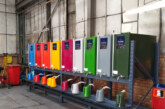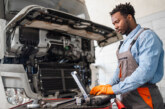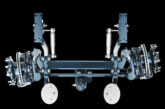How to ensure long-lasting air springs

Correct installation and proper maintenance are the bedrock of long-lasting air springs, says Lee Harris, parts specialist at Diesel Technic UK and Ireland. Here he highlights some common faults, and some tips on how to avoid them.
Air springs aren’t all made equal. There are various types to suit different chassis designs: some come with a top mounting plate paired with a steel or plastic piston, while others are more straightforward – just a basic bag without a top plate or piston. Then there are those that screw directly into the frame, and of course, lift bags used on lift axles.
Fit the wrong one, and the fault won’t stay hidden for long. If the replacement bag is too short, there’s a risk the top plate could distort, or a rotary piston might slip out from underneath. That’s why it’s vital to always match the air spring to the correct OE specification.
Before you fit a new one…
Before fitting a replacement, Diesel Technic’s parts specialists strongly advise getting to the bottom of why the original failed. In many cases, air spring damage is avoidable – and often stems from simple mistakes.
One common culprit is overtightening. An over-torqued nut can deform or crack a component, while foreign objects can cause abrasion marks that gradually wear through the rubber. Always look out for signs of thermal overload too. If a brake system has overheated, the excess heat can transfer to the spring – and as a result the air spring can rip and leak.
Don’t ignore signs of porous or fatigued material during your safety check. If that’s the case, it’s also wise to inspect the braking system itself – chances are, there’s a fault that needs addressing.
A snapped mounting bolt is another telltale sign that someone’s exceeded the recommended torque. Every DT spare parts component comes labelled with the correct torque settings, so double check these during installation to ensure they match OEM specs.
When it’s time to replacement
During replacement, it’s essential to follow correct torque specs, not only for the mounting bolts, but for the compressed air hose as well. If you don’t, the resulting vibrations can loosen fasteners or – in extreme cases – cause them to tear off completely.
Watch out for damaged or kinked air hoses too, particularly when routing them into place. Poor cable management can quickly lead to leaks or system failure.
And while it may seem obvious, it’s worth repeating: always clear any debris or foreign objects from the spring’s working area before installation. Neglect this step, and you could end up damaging the new unit before the truck even leaves the bay.
After fitting, the Diesel Technic parts specialists team recommends carrying out a suspension calibration to restore correct ride height and ensure optimal driving behaviour.
Need more help?
Whether you’re in the workshop or managing a fleet, having the right parts information at the right time makes all the difference. As the dedicated Diesel Technic parts specialist for the UK, I’m here to support your workshop with advice on DT spare parts, answers to technical questions, brand insight, and details on the Diesel Technic premium shop rewards programme. I’m always out on the road, visiting workshops across the country.
To book a visit or arrange an appointment, just call 07506726844 or email lee.harris@dieseltechnic.com.









